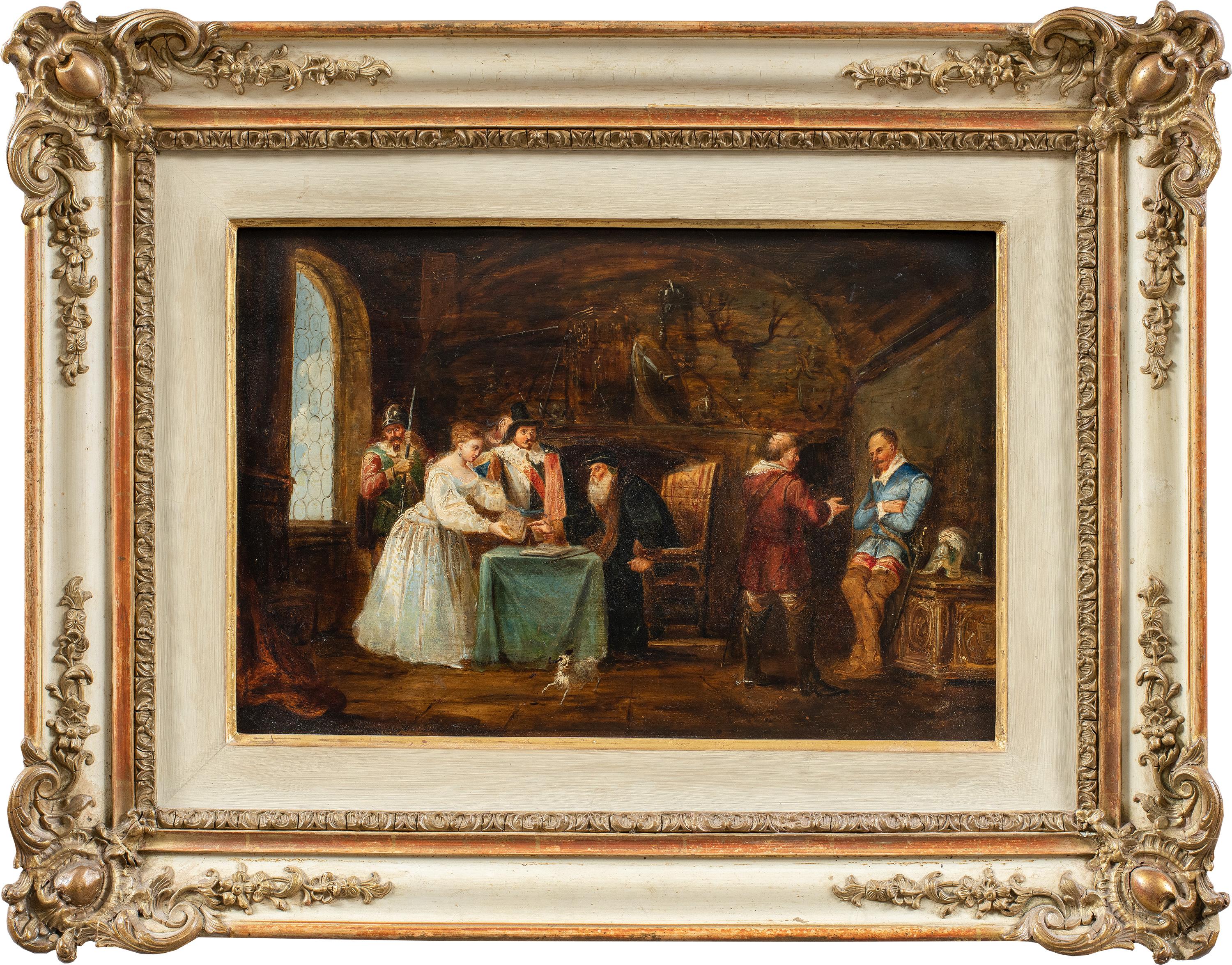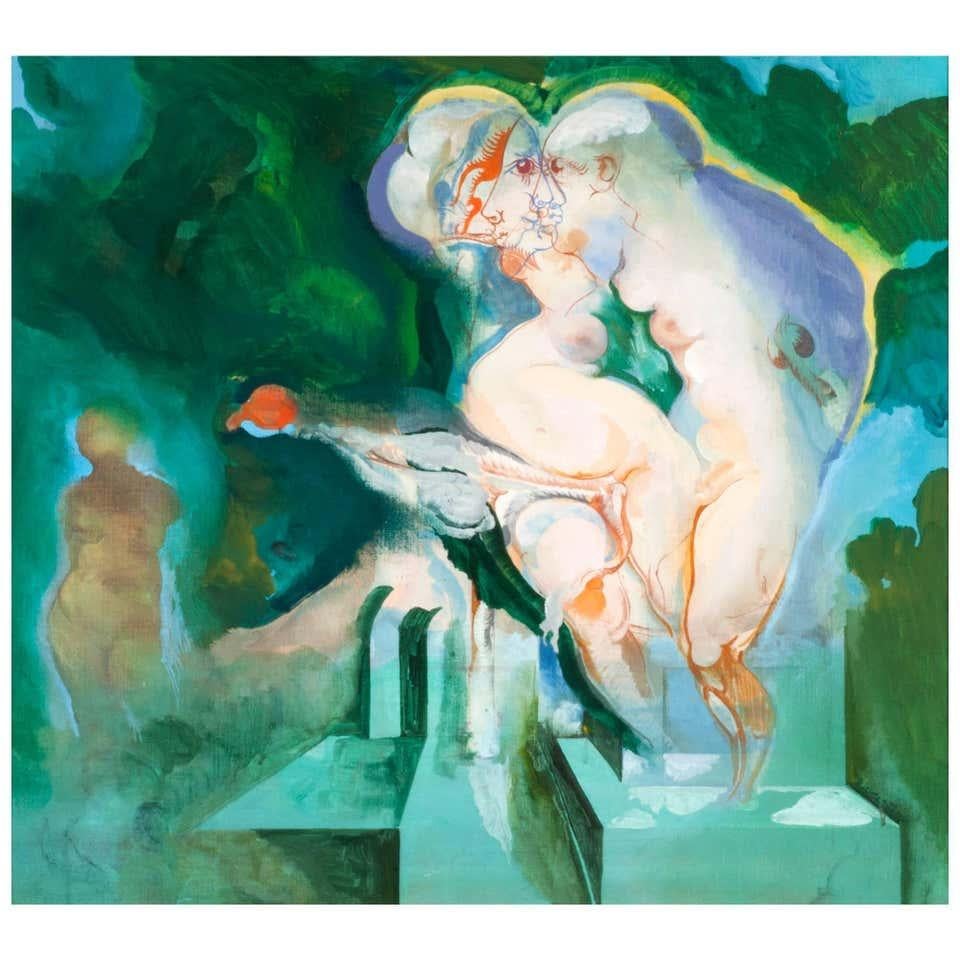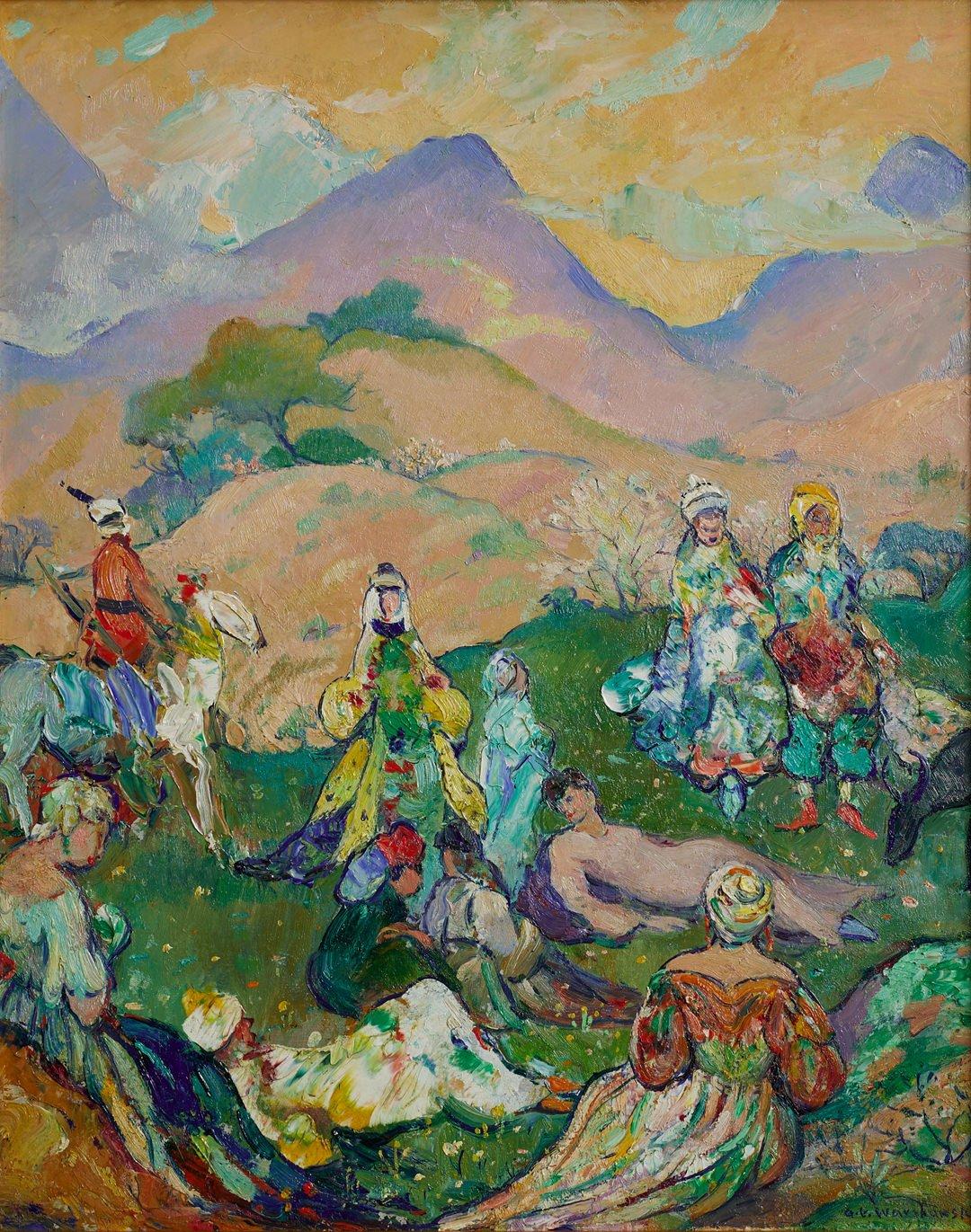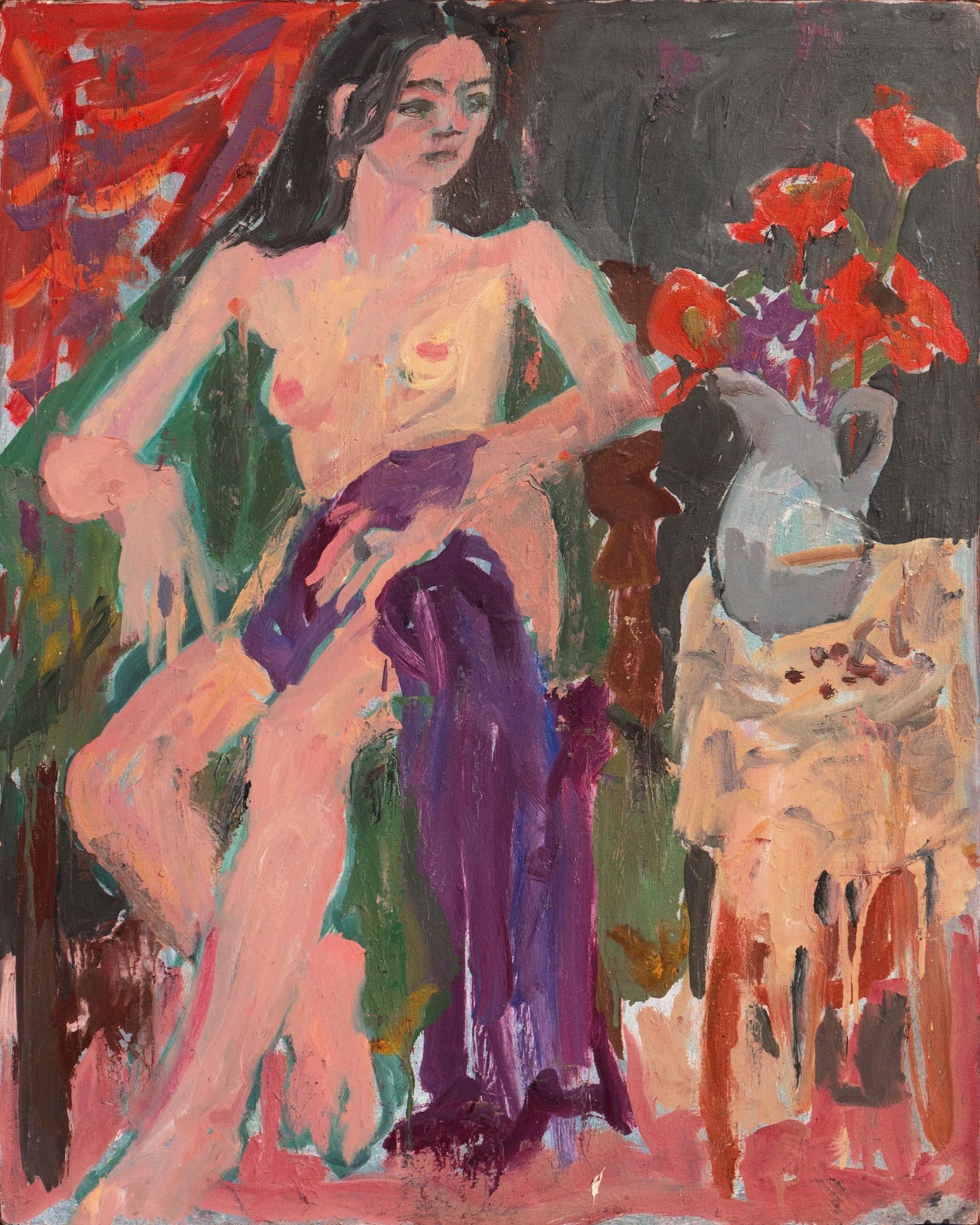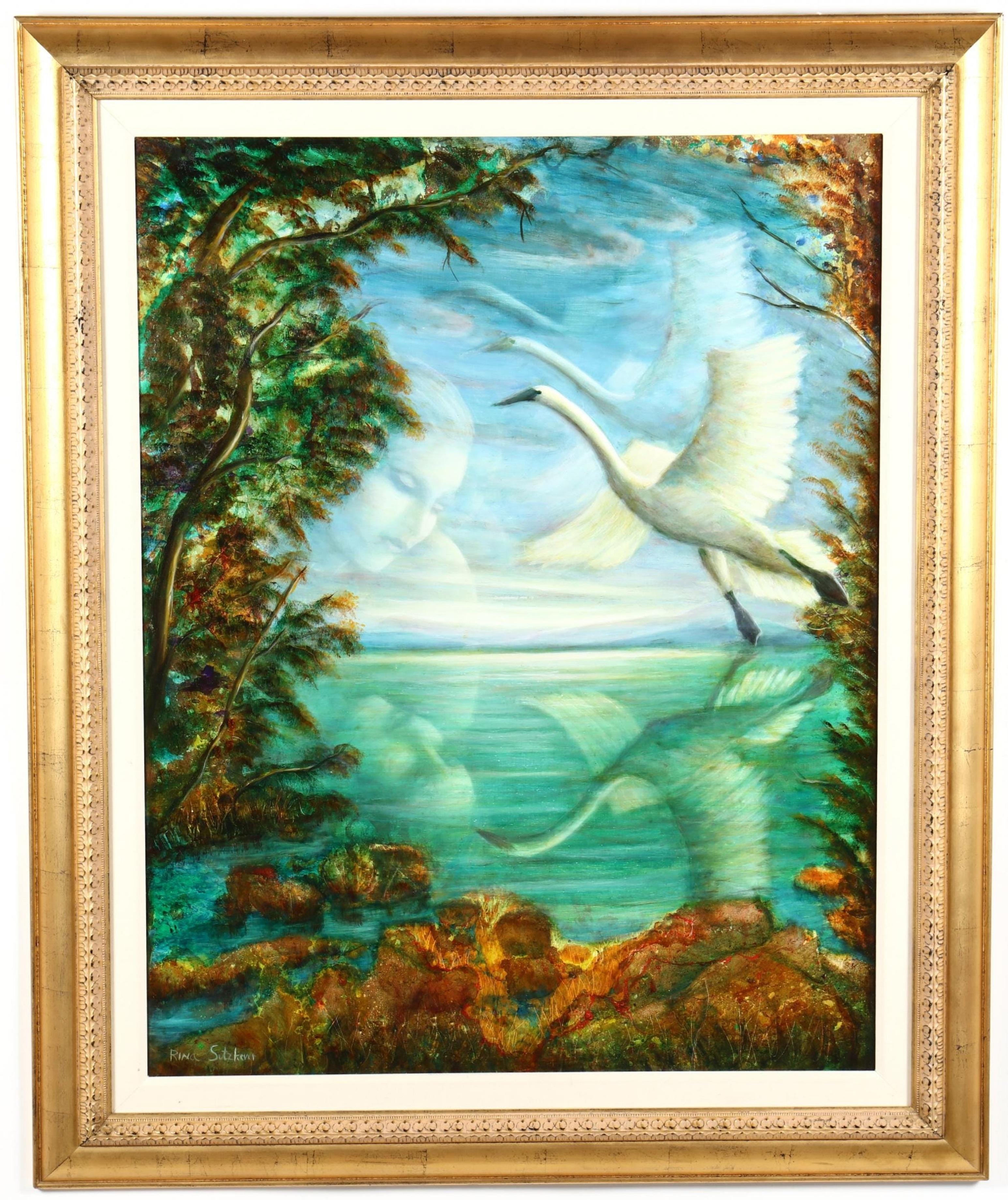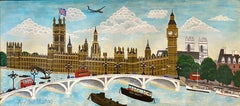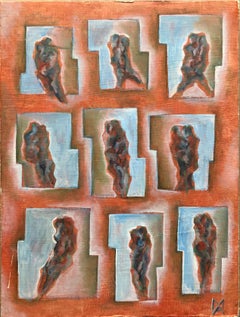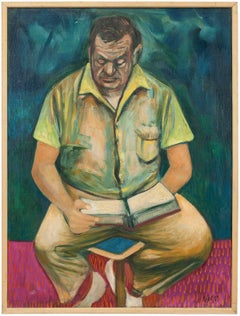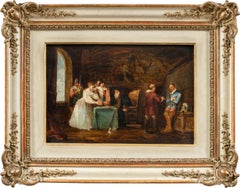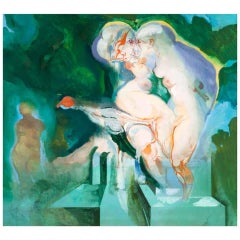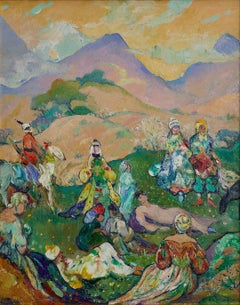Items Similar to Jewish Wedding Chuppah Scence, Judaica
Want more images or videos?
Request additional images or videos from the seller
1 of 7
Raoul RaymondJewish Wedding Chuppah Scence, Judaica
About the Item
Raoul Raymond was born in Bucharest, Romania in 1948 and he immigrated to Israel two years later.
In Israel, Mr. Raymond grew fond of the artist's palette, and at an early age, was guided by Israeli artist Ton Bernhard.
Mr. Raymond studied at the Lyceum og Graphis in Tel Aviv, and in 1965 continued his studies at the Academie des Beaux Arts in Paris.
He returned to Israel in 1967 and entered the military service, taking part in the Six Day War.
Raoul Raymond has taken part in many group shows, both in Israel and abroad, notably in Europe. He paints in an impressionistic style, capturing characteristic Israeli scenes in his warm, vibrant colors.
- Creator:Raoul Raymond (1948, Israeli, Romanian)
- Dimensions:Height: 27.5 in (69.85 cm)Width: 15.75 in (40.01 cm)
- Medium:
- Period:
- Condition:Measurements include frame.
- Gallery Location:Surfside, FL
- Reference Number:1stDibs: LU38211365512
About the Seller
4.9
Platinum Seller
Premium sellers with a 4.7+ rating and 24-hour response times
Established in 1995
1stDibs seller since 2014
1,744 sales on 1stDibs
Typical response time: 2 hours
- ShippingRetrieving quote...Shipping from: Surfside, FL
- Return Policy
Authenticity Guarantee
In the unlikely event there’s an issue with an item’s authenticity, contact us within 1 year for a full refund. DetailsMoney-Back Guarantee
If your item is not as described, is damaged in transit, or does not arrive, contact us within 7 days for a full refund. Details24-Hour Cancellation
You have a 24-hour grace period in which to reconsider your purchase, with no questions asked.Vetted Professional Sellers
Our world-class sellers must adhere to strict standards for service and quality, maintaining the integrity of our listings.Price-Match Guarantee
If you find that a seller listed the same item for a lower price elsewhere, we’ll match it.Trusted Global Delivery
Our best-in-class carrier network provides specialized shipping options worldwide, including custom delivery.More From This Seller
View AllLarge Russian Israeli Fantastic Realism Surrealist Oil Painting Girl with Swan
By Rina Sutzkever
Located in Surfside, FL
Rina Sutzkever Calderon (Russian/Israeli, b. 1945), Fly Away
Oil on canvas, signed at lower left, presented in a gilt frame with linen liner.
Frame dimensions 56 x 46 in.
Rina Sut...
Category
20th Century Surrealist Animal Paintings
Materials
Canvas, Oil
Naive London Street Scene Folk Art Oil Painting Big Ben, Parliament, Union Jack
By Andrew Murray
Located in Surfside, FL
Big Ben, House of Parliament with Union Jack flag, Thames River, boats, barges, airplane and double decker red bus. Classic London street scene.
24 inches by 11 inches in a frame 24....
Category
20th Century Folk Art Figurative Paintings
Materials
Canvas, Oil
Matthias Alfen German Sculptor Modern Expressionist Painting Psychogram
By Matthias Alfen
Located in Surfside, FL
Matthias Alfen’s series of Janus figures are an innovation in figural art predicated on the advances made by the Futurist sculptor and painter Umberto Boccioni and the Modernist Alberto Giacometti. The qualities of chance and spontaneity, necessarily excluded in the sculptural work, are clearly evident in his drawings and paintings. “Psychograms” of unchoreographed hand movements display wide variation, repeatedly playing through one form after another. In the end, this multitude of variation serves to enhance the logic, consistency, and seductively rich appearance of Alfen’s designed sculptural works. Represented by Gallery Schuckin in New York, Paris, France, and Moscow, Russia.
Matthias Alfen’s was strongly influenced by his family’s experience during World War II. His grandfather Klemens Alfen (1894-1955) was an accomplished painter and photographer, recognized for his landscape photography and for his technique (Special Honors for Excellence in Photo-Print Technology, 1932). He enjoyed the friendship and support of many in the artistic community, a community largely influenced by its German Jewish members. Having lost his entire circle of friends under Nazi oppression. Klemens, although not Jewish, also suffered under the Nazis for refusing to join them and struggling in post-war Germany, which had nothing to offer an artist like him, Klemens took his own life.
At around the age of 16 he worked for some weeks as an assistant at his uncle’s art studio. Fritz Koenig...
Category
Late 20th Century Neo-Expressionist Abstract Paintings
Materials
Plywood, Oil
Middle Age Aint That Bad. (Retiree Reading a Book)
By David Rosen (b.1912)
Located in Surfside, FL
DAVID ROSEN
Toronto, Canada, b. 1912, d. 2004
Painter David Rosen emerged onto the art scene while the country was wrought with unimaginable economic turmoil. Like most other Americans, the Great Depression pummeled artists financially, leaving them destitute and unable to find even conventional labor work. However, in the midst of such devastation, the government implemented arts projects which strove to achieve employment for these artists. The program arose during a memorable era for art and funded the careers of several renowned artists, including Jackson Pollack, Arshile Gorky, and Lee Krasner before they found success. In 1936, Rosen himself joined the program and quickly accompanied his contemporaries in building the next movement of modern art, Abstract Expressionism.
Born in 1912, Rosen grew up in Toronto, Canada before pursuing arts in the United States. Upon arriving, Rosen settled in New York City and attended the Cooper Union Art school in 1930. While participating in the Federal Arts Project, he worked for the program's mural department until 1941. As well, he worked with an artist collective, Siqueiros Art Workshop. There, Rosen met fellow FAP artist Jackson Pollack, and together, with artist Phillip Guston, they experimented with new painting techniques and mediums. Art movements are often reactions to the popular styles that precede them, and Abstract Expressionism applied a new and exciting method to Modern Art. Gradually, artists began to break away from an overly-studied, academic approach to painting and liberated their technique. During these workshops, Rosen was introduced to Pollack's groundbreaking "drip painting" before it changed the art world.
As America became involved in World War II, the Federal Arts Project wound down, officially ending in 1942. Around this time, Rosen enlisted as a Merchant Seaman with the U.S Merchant Marines. During this time, he traveled to North Africa and Italy before concluding his service and moving to California where, in 1945, he devoted his full attention to building an art career. Within a couple of years, he landed a major exhibition at the Los Angeles County Museum of Art in 1947, and his first one-man show, which opened to rave reviews, was held at Hollywood's Contemporary Art Gallery. The exhibition’s success led to mural commissions from Palm Springs' Hotel del Tahquitz, and he scored more solo shows at West Hollywood's Chabot Gallery.
The early 1950s brought a surge of recognition for Rosen's career, and while his work was certainly still influenced by Abstract Expression, his painting style included elements of Surrealism, Figurative Art, and Cubism. Like his colleague Jackson Pollack, Rosen produced work inspired by drip painting; however, rather than splattering, his drips were the natural flow marks from painting freely without regard for "mistakes." Throughout Rosen's long career, he would acquire techniques from vastly different art styles which made for a varied, eclectic catalog of work.
Rosen continued to build his California art career and settled at a Laguna Beach art colony in 1958. There, he entered his work in the Laguna Beach Festival of Arts and was the first painter to contribute Abstract Art to the event. Rosen would participate in the festival for the next fifteen years. A year after his move, in 1959, Rosen opened his first studio gallery and began a 12-year collaboration with the Laguna Playhouse. For the next two decades, Rosen participated in 17 art exhibitions and 20 solo shows, and received considerable critical praise.
Rosen's themes were as varied as his evolving painting style, and one of his themes focused on classic characters like Shakespeare's Hamlet. Rosen's close-up portraits of historical and literary figures, illustrated by the piece To Be or Not to Be: Soliloquy From Hamlet, capture the essence of the characters while remaining loose with the painting and even adding a slight cartoon feel. His ongoing Hamlet series, as a complete collection, makes an impact with the diversity of technique. Unlike the loose style of some of his works, the painting Madaam... that he is mad is true is influenced by the structure of Cubism, the flat dimensions of Byzantine Art, and his utilization of mixed media.
After Rosen's death in 2004, the Laguna Beach Festival of Arts sponsored an exhibition of his Hamlet paintings at the Wells Fargo Building gallery. Throughout Rosen's career, he amassed a great deal of critical, industry, and public praise for his work. His beloved town of Laguna Beach bestowed numerous awards that include the Laguna Beach Annual Art Gallery Award and Orange County's Annual Exhibit Award. Rosen's work flourished in California, and he received recognition from the San Diego County Fair, Los Angeles' Miracle Mile...
Category
20th Century Modern Figurative Paintings
Materials
Canvas, Oil
Jewish Peddlers on Market Day Modernist Judaica OIl Painting Cubist Abstraction
By Samuel Sigaloff
Located in Surfside, FL
Sam Sigaloff (1895-1987) signed in the lower right. Vibrant market scene oil on canvas.
Category
20th Century Figurative Paintings
Materials
Canvas, Oil
Large Naive European Folk Art Oil Painting Lazar Obican French Scarecrow Clown
Located in Surfside, FL
Lazar Obican 1944-2004
Genre: Other
Subject: People
Medium: Oil
Surface: Canvas
Dimensions: 35" x 16.5
Dimensions w/Frame: 35.5" x 17.25
An impasto composition that depicts a colorful scarecrow clown with a bird perched on his shoulder with a bottle of French Vin (wine)
Artist signature L OBICAN to bottom and dated 1968. Title to verso.
Work Size: 36 x 25 in. Framed 37.5 x 26 x 1 in
The artist Lazar Obican iconic style is child-like yet masterfully adult; a style that tells a story with sociological overtones. His funny little people are always colorful, full of spirit, living with music and birds to bring them happiness.
Lazar Obican artist, painter, sculpture and mosaic ceramic artisan was born in Cannes, France, to his Yugoslavian family. He finished his training, imbued with the spirit of his native country, the people, their legends, and their philosophy. It has been said that his work has a "timeless quality" and a naive, folk art, outsider art brut quality, child-like primitive style. Obican is identified with his style the world over, a style that is simple yet sophisticated; child-like yet masterfully adult; a style that tells a story with psychological, philosophical or sociological overtones. His funny little people are always colorful, full of spirit, living with music and birds to bring them happiness. Best known for his depictions of folklore and traditional costumes rendered in a playful, childlike style and for his happy Jewish wedding scenes. He often used bright colors and black outlines in his renderings of figures and animals, giving his work an illustration-like quality. Thematically, the artist’s work is similar to Marc Chagall and Jean Dubuffet for its dreamlike images and so-called naïve style of painting. Over the course of his career, the artist maintained a studio in Boca Raton, Florida and Dubrovnik, Croatia—part of former Yugoslavia— where he developed an interest in Eastern Europe’s Jewish culture. Many of his mature works depict Jewish traditions and ceremonies, including traditional Jewish weddings, the dancing of the Hora, and traditional music. There is a display of his works in his former Dubrovnik studio.
His style is a unique conglomerate of tradition, history, legends, heroes, old customs and folklore. It is a self-standing style, recognizable, cheerful, whimsical and a happy creation. Naïve art is any form of visual art that is created by a person who lacks the formal education and training that a professional artist undergoes (in anatomy, art history, technique, perspective, ways of seeing). Unlike folk art, naïve art does not necessarily evince a distinct cultural context or tradition. Naïve art is recognized, and often imitated, for its childlike simplicity and frankness. Paintings of this kind typically have a flat rendering style with a rudimentary expression of perspective.
One particularly influential painter of "naïve art" was Henri Rousseau (1844–1910), a French Post-Impressionist who was discovered by Pablo Picasso. Naïve art is often seen as outsider art that is by someone without formal (or little) training or degree. While this was true before the twentieth century, there are now academies for naïve art. Naïve art is now a fully recognized art genre, represented in art galleries worldwide.
Museums devoted to naïve art now exist in Kecskemét, Hungary; Riga, Latvia; Jaen, Spain; Rio de Janeiro, Brasil; Vicq France and Paris. "Primitive art" is another term often applied to art by those without formal training, but is historically more often applied to work from certain cultures that have been judged socially or technologically "primitive" by Western academia, such as Native American, sub saharan African or Pacific Island art (see Tribal art). This is distinguished from the self-conscious, "primitive" inspired movement primitivism. Another term related to (but not completely synonymous with) naïve art is folk art. There also exist the terms "naïvism" and "primitivism" which are usually applied to professional painters working in the style of naïve art (like Paul Gauguin, Mikhail Larionov, Paul Klee).
At all events, naive art can be regarded as having occupied an "official" position in the annals of twentieth-century art since - at the very latest - the publication of the Der Blaue Reiter, an almanac in 1912. Wassily Kandinsky and Franz Marc, who brought out the almanac, presented 6 reproductions of paintings by le Douanier' Rousseau (Henri Rousseau), comparing them with other pictorial examples. However, most experts agree that the year that naive art was "discovered" was 1885, when the painter Paul Signac became aware of the talents of Henri Rousseau and set about organizing exhibitions of his work in a number of prestigious galleries. The Earth Group (Grupa Zemlja) were Croatian artists, architects and intellectuals active in Zagreb from 1929 to 1935. The group included the painters Krsto Hegedušić, Edo Kovačević, Omer Mujadžić, Kamilo Ružička, Ivan Tabaković, and Oton Postružnik, the sculptors Antun Augustinčić, Frano Kršinić, and the architect Drago Ibler. A term applied to Yugoslav (Croatian) naive painters working in or around the village of Hlebine, near the Hungarian border, from about 1930. Some of the best known naive artists are Dragan Gaži, Ivan Generalić, Josip Generalić, Krsto Hegedušić, Mijo Kovačić, Ivan Lacković-Croata, Franjo Mraz, Ivan Večenaj and Mirko Virius. Camille Bombois (1883–1970) Ferdinand Cheval, known as 'le facteur Cheval' (1836–1924) Henry Darger (1892–1973) L. S. Lowry (1887–1976) Grandma Moses, Anna Mary Robertson (1860–1961) Nikifor (1895–1968) Poland, Horace Pippin (1888–1946) Jon Serl (1894-1993) United States Alfred Wallis (1855–1942) Scottie Wilson (1890–1972) Gesner Abelard (b. 1922) Jan Balet (1913–2009) Michel Delacroix (b. 1933) France Howard Finster (1916–2001) Ivan Rabuzin (1921–2008)
Spontaneous Art Museum in Brussels
Art en Marge Museum in Brussels
MADmusée in Liege
International Museum of Naive Art of Brazil...
Category
1960s Folk Art Figurative Paintings
Materials
Canvas, Oil
You May Also Like
Romantic Italian painter - 19th century figure painting - Historical scene
Located in Varmo, IT
Italian painter (dated 1853) - Historical interior scene.
29.5 x 43 cm without frame, 50 x 65 cm with frame.
Antique oil painting on panel, in a contemporary carved wooden frame, l...
Category
Mid-19th Century Romantic Interior Paintings
Materials
Oil, Panel
$2,321 Sale Price
20% Off
Free Shipping
Heinrich Richter "#50", 1969
Located in Washington, DC
Oil on canvas painting by Heinrich Richter (German/Polish, 1920-2007). Painting is titled #50, signed and dated 1969. Heinrich Richter has had numerous solo and group exhibitions in ...
Category
1960s Surrealist Figurative Paintings
Materials
Oil, Canvas
$1,700 Sale Price
50% Off
Spring Fantasy, Mid-20th Century American Impressionist Landscape
By Abel Warshawsky
Located in Beachwood, OH
Abel Warshawsky (American 1883-1962)
Spring Fantasy, 1948
Oil on artist's board
Signed lower right and verso
16 x 13 inches
20 x 17 inches, framed
Impressionist painter A.G. Warshaw...
Category
1940s American Impressionist Landscape Paintings
Materials
Oil
'Seated Nude with Flowers' Paris, Louvre, Académie Chaumière, SFAA, LACMA
By Victor Di Gesu
Located in Santa Cruz, CA
Accompanied by certificate of authenticity for Victor Di Gesu (American, 1914-1988) and painted circa 1955. Additional painting, verso, with old inscription by the artist's wife, Jan...
Category
1940s Post-Impressionist Figurative Paintings
Materials
Oil, Masonite
Sloan
By René Romero Schuler
Located in Napa, CA
René Romero Schuler is an American painter and sculptor who creates powerful images that speak to the complexities of the human condition and the spirit that connects all human bein...
Category
2010s Contemporary Figurative Paintings
Materials
Canvas, Oil
"SUSPENSE on paper" painting of a woman in red suit gliding beneath the water
By Carol Bennett
Located in Edgartown, MA
"I throw myself into the water almost every day- it grounds me, the body floats and the mind drifts. The "Swimmer series" has followed me over the years, resurfacing and evolving. Pr...
Category
2010s Contemporary Figurative Paintings
Materials
India Ink, Oil, Acrylic, Paper
Recently Viewed
View AllMore Ways To Browse
Judaica Artist
Jewish Wedding Painting
Israeli Judaica Art Oil Paintings
Philip Held
Collier Vintage
Hyperrealism Oil Paintings
Spain Santiago
Staircase Painting
Velvet Paintings
Village Girls
Wes Gordon
17th Century Saint Paintings
Academy Ring
Haiti Painting
Haitian Painting
Holy Family Painting
Ballet Dancer Oil Painting
Balloon Frame
